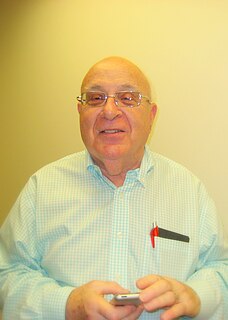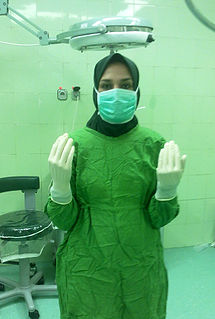
An engineering technologist is a professional trained in certain aspects of development and implementation of a respective area of technology. Engineering technology education is even more applied and less theoretical than engineering education, though in a broad sense both have a focus on practical application. Engineering technologists often assist engineers but after years of experience, they can also become engineers. Like engineers, areas where engineering technologists can work include product design, fabrication and testing. Also as with engineers, engineering technologists sometimes rise to senior management positions in industry or become entrepreneurs.

David J. Farber is a professor of computer science, noted for his major contributions to programming languages and computer networking. He is currently the Distinguished Professor and Co-Director of Cyber Civilization Research Center at Keio University in Japan. He has been called the "grandfather of the Internet".

A surgical technologist, also called a scrub, scrub tech, surgical technician, or operating room technician, is an allied health professional working as a part of the team delivering surgical care. Surgical technologists are members of the surgical team. The members of the team include the surgeon, surgeon's assistant, circulator nurse and anesthesia provider. They possess knowledge and skills in sterile and aseptic techniques. There are few mandatory professional requirements for surgical technologists, and the scope of practice varies widely across countries and jurisdictions. Surgical technologists attend junior colleges and technical schools, and many are trained in military schools. In the military they perform the duties of both the circulator and the scrub. The goal is for surgical technologists to be able to anticipate the next move the surgeon is going to make in order to make the procedure as smooth and efficient as possible. They do this by having knowledge of hundreds of surgical procedures and the steps the surgeon needs to take in order to complete the procedure, including the very wide range of surgical instruments they may need. Specialties can include, but are not limited to, the following: genitourinary, obstetrics and gynaecology, urology, ENT, plastics, general, orthopedics, neurology, and cardiovascular. They only work in surgical or perioperative areas and are highly specialized. Surgical technologist is the proper term for a 2 year program which earns a degree in Applied Sciences. The profession is up and coming and highly in demand.
The Sydney Accord is an international mutual recognition agreement for qualifications in the fields of engineering technology.
Mechanical Engineering Technology is the application of engineering principles and technological developments for the creation of useful products and production machinery.

Ahsanullah University of Science and Technology, commonly known as AUST, is a private (Engineering) University in Bangladesh. It was founded by the Dhaka Ahsania Mission in 1995.
The National Institute for Certification in Engineering Technologies (NICET) is an organization that was established in 1961 to create a recognized certification for engineering technicians and technologists within the United States. A 1981 study by the National Cooperative Highway Research Program (NCHRP), requested by the American Association of State Highway and Transportation Officials' SubCommittee On Construction, prompted the National Society of Professional Engineers (NSPE) to merge two certification bodies; the Institute for the Certification of Engineering Technicians (ICET) and the Engineering Technologist Certification Institute. The result is a nonprofit organization that provides a nationally recognized and accepted procedure for recognition of qualified engineering technicians and technologists.

An engineering technician is a professional trained in skills and techniques related to a specific branch of technology, with a practical understanding of the relevant engineering concepts. Engineering technicians often assist engineers and engineering technologists in projects relating to research and development, or focus on post-development activities like implementation or operation. An engineering technician is between a skilled craft worker and an engineering technologist.

Electrical/Electronics engineering technology (EET) is an engineering technology field that implements and applies the principles of electrical engineering. Like electrical engineering, EET deals with the "design, application, installation, manufacturing, operation or maintenance of electrical/electronic(s) systems." However, EET is a specialized discipline that has more focus on application, theory, and applied design, and implementation, while electrical engineering may focus more of a generalized emphasis on theory and conceptual design. Electrical/Electronic engineering technology is the largest branch of engineering technology and includes a diverse range of sub-disciplines, such as applied design, electronics, embedded systems, control systems, instrumentation, telecommunications, and power systems.
Industrial technology is the use of engineering and manufacturing technology to make production faster, simpler, and more efficient. The industrial technology field employs creative and technically proficient individuals who can help a company achieve efficient and profitable productivity.
Cardiovascular technologists are health professionals that deal with the circulatory system.
The Canadian Council of Technicians and Technologists (CCTT) is an organization in Canada that advocates for the profession of technicians and technologists, as well as certifying their respective educational programs.
The Diploma in Engineering or Diploma in Technical Education or Technical Diploma is a program focused on practical and skills-oriented training. It is a technical course that only covers the essentials when ranked with an undergraduate engineering degree. It aims to provide students with industry or job related engineering knowledge, scientific skills, computing and analysis, mathematical techniques, a sound knowledge of English to communicate in the field and ability to apply problem-solving techniques.

A drafter is an engineering technician who makes detailed technical drawings or plans for machinery, buildings, electronics, infrastructure, sections, etc. Drafters use computer software and manual sketches to convert the designs, plans, and layouts of engineers and architects into a set of technical drawings. Drafters operate as the supporting developers and sketch engineering designs and drawings from preliminary design concepts.
National Board of Diving and Hyperbaric Medical Technology (NBDHMT), formally known as the National Association of Diving Technicians, is a non-profit organization devoted to the education and certification of qualified personnel in the fields of diving and hyperbaric medicine.
Technologist may refer to:

Marine technology is defined by WEGEMT as "technologies for the safe use, exploitation, protection of, and intervention in, the marine environment." In this regard, according to WEGEMT, the technologies involved in marine technology are the following: naval architecture, marine engineering, ship design, ship building and ship operations; oil and gas exploration, exploitation, and production; hydrodynamics, navigation, sea surface and sub-surface support, underwater technology and engineering; marine resources ; transport logistics and economics; inland, coastal, short sea and deep sea shipping; protection of the marine environment; leisure and safety.

The Certified Technicians and Technologists Association of Manitoba (CTTAM) is a regulated profession in Manitoba responsible for certifying engineering/applied science technicians and technologists. The Certified Applied Science Technologists Act assented on June 29, 1998.
The Applied Science Technologists and Technicians of British Columbia (ASTTBC), is British Columbia's independent certifying body for engineering/applied science technicians and technologists.








